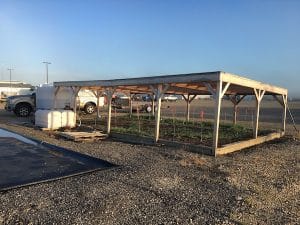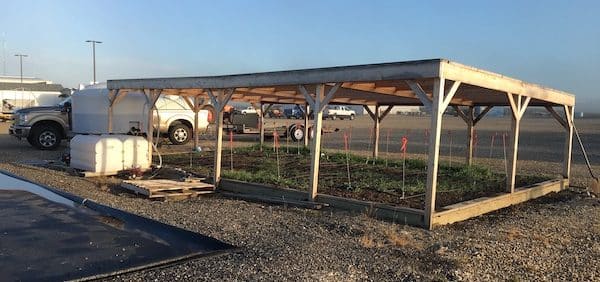What is a biobed? A pesticide rinsate biobed is a structure designed to remove pesticides from the water used to rinse sprayers. The biobed itself is a lined pit or box. It has weeping tile and a piping system to remove effluent after it has trickled to the bottom. The biobed contains a ‘biomix’ of three ingredients: chopped cereal straw, peat and coarse-textured soil. After moistening the mix and letting it sit for four to six weeks, the natural pesticide-digesting microbial complex is ready to work. The setup requires a sprayer rinse area with a sump to collect the rinsate. It also requires a tank to hold rinsate, which is then applied dripwise over the biobed. Quite likely, biobeds in Canada will require a heating system to warm up the biomix so it’s ready to go in May. Effluent from the biobed can be recycled to irrigate non-cropped areas, such as yards.
Why build one? A pesticide rinsate biobed can prevent the environmental contamination of surface and groundwater by pesticides. Instead of being disposed of directly on land, at the edge of a field or elsewhere, the rinsate from the sprayer can be applied to the biobed (so it is contained).
Who should build one? Currently, several experimental farms of Agriculture and Agri-Food Canada use biobeds or are planning to build biobeds in the near future. The County of Grande Prairie in Alberta has one. (See below for more about their experience.) Anyone using pesticides in significant volumes should consider building a biobed on their operation, including municipalities for their roads and parks maintenance programs, golf courses, private farming and greenhouse operations.
How to build one? The answer is fairly detailed. Here are two excellent Canadian resources:
- AAFC’s biobed construction and maintenance manual
- Tom Wolf has a ‘how-to’ article on his Agrometrix website.
*Credit for this article goes to the late Claudia Sheedy with AAFC. Sheedy researched biobeds and created, along with colleagues Larry Braul and Sharon Reedyk, the biobed manual linked above.
First hand experience with a biobed

The County of Grande Prairie in the Peace region of Alberta has had an operational biobed since 2014. It was built into the ground based on Tom Wolf’s design. Kim Robson, the county’s agriculture officer for vegetation management, measures pesticide levels for everything going into and out of the biobed. “Nothing goes in or out that I don’t know about,” she says.
Robson says most pesticides are reduced by 98 to 99 per cent, except for clopyralid, which is well documented to be less-effectively broken down in a biobed.
The county’s biobed is 16 feet wide, 30 feet long and four feet deep. The hole was first lined with a polyethylene liner. Weeping tile was laid down and covered with pea gravel and then geotextile fabric. The hole was then filled with the biobed biomix of two parts barley straw, one part topsoil and one part compost.
Their process follows three steps: 1) Spray out the rinsate onto a plastic-lined catchment area. 2) Pump that rinsate into a larger holding tank. 3) Dribble rinsate over the biobed at a rate of 1cm depth per cycle. Robson has a irrigation hose laid out over the top of the biobed and turns on the hose for one hour (enough to achieve the 1cm depth) three times a week.
Robson’s first recommendation for anyone considering a biobed would be to measure the amount of sprayer rinsate they produce in a year. “Then size the biobed accordingly,” she says. If doing it again, she might opt for a smaller above-ground version that would be easier to set up and maintain. And while the county doesn’t have a heating system in its biobed, Robson says anyone handling rinsate in May might want to have a heating coil at the bottom of the biomix to get it thawed and working before the season starts. Robson would also recommend a rinsate catchment pad that the sprayer can drive right over top, for convenience of large equipment.
“I think biobeds are a good idea,” Robson says. “It would be good to have a farmer set one up to show other farmers that it can make sense for them.”

